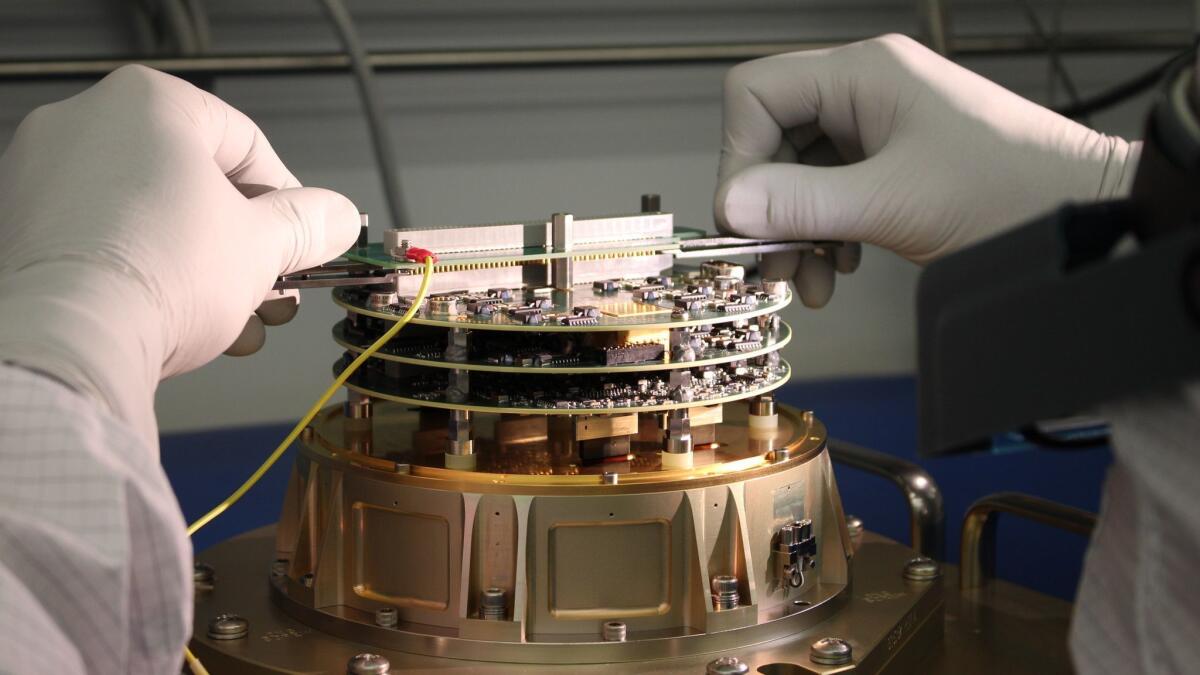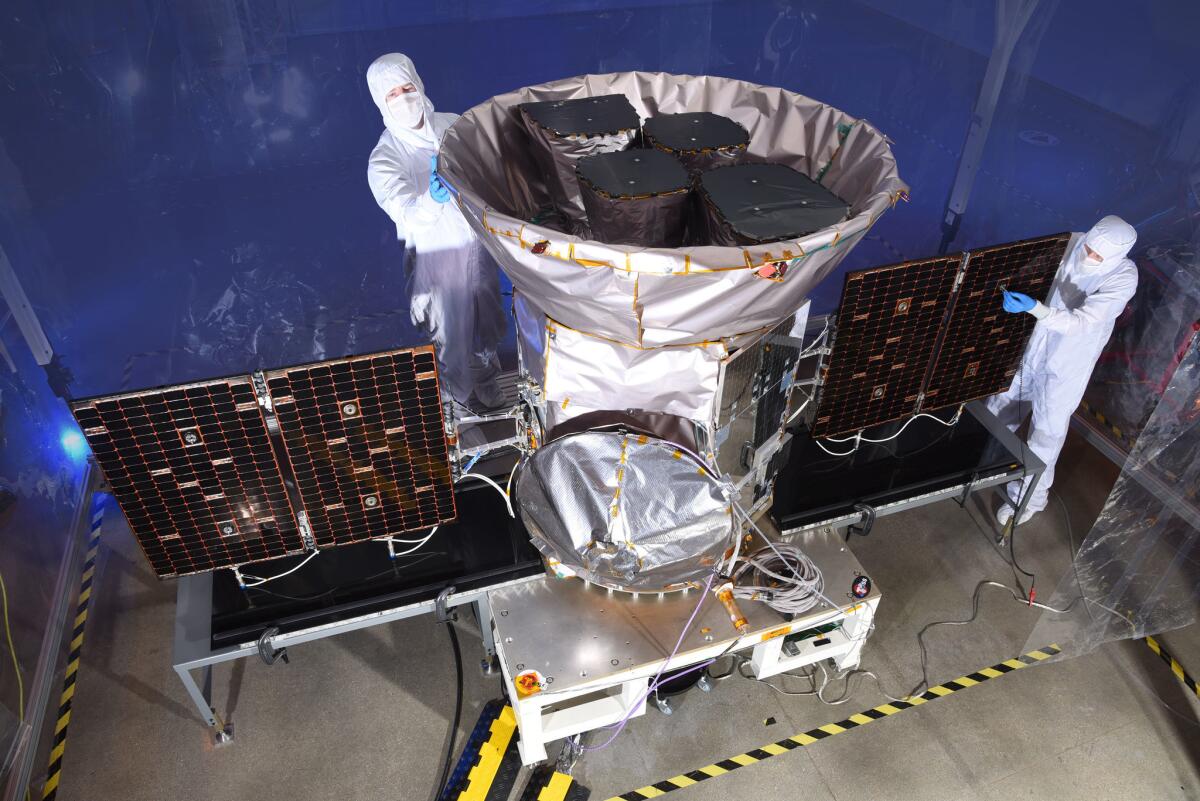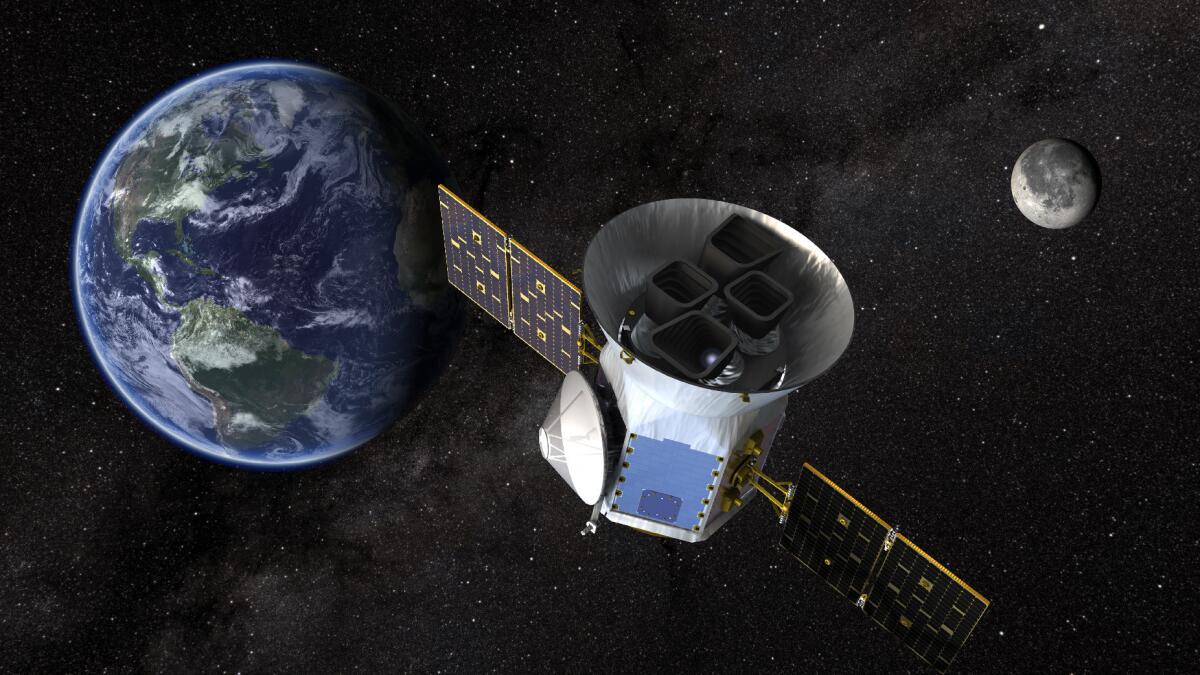NASA is about to step up its planet-hunting game with the launch of TESS
On a cold, clear night in January, MIT astrophysicist George Ricker and his students stepped onto a rooftop on campus and aimed a camera at the highest point in the sky.
That camera, an engineering model of the four being launched with NASA’s TESS mission, revealed a night so thick with stars that they obscured the normally distinct constellations.
“In two seconds you could see things that were a hundred thousand to a million times fainter than what you could see with your naked eye,” said Ricker, the mission’s principal investigator.
The test offered a small taste of what TESS, the Transiting Exoplanet Survey Satellite, will discover after it launches, which could occur as early as Monday afternoon. The spacecraft will scan almost all of the sky for neighboring stars, searching for the dips in their brightness that signal the presence of a planet.
The goal: to find planets that are smaller than Neptune, with a radius less than about four times that of Earth. Scientists will then use other telescopes to measure the masses of 50 of them.
A few of the worlds TESS finds may be small, rocky bodies, like Earth. And a few of those might, just possibly, be habitable places for life as we know it.
“It’s very exciting,” Ricker said. “We’re getting a chance to potentially answer a question that humanity’s always been interested in: What’s in the sky? And are there other beings, other places like Earth?”
Astronomers have been searching for planets beyond our solar system for decades.
Some of their first discoveries were confirmed in the 1990s. Among them were exoplanets that were detected by ground-based telescopes that looked for the periodic wobble in a star’s motion caused by a planet’s tiny tug — a technique known as the radial velocity method. Others were found by searching for variations in the predictable rhythms of pulsars.
About 325 exoplanets had been discovered by the time NASA launched the Kepler Space Telescope in 2009. It employed the transit method, staring deep into a patch of sky and looking for the shadows cast by planets as they crossed in front of their host stars.
Kepler was a full-time planet hunter, and it revolutionized astronomers’ understanding of exoplanets. It was particularly interested in finding Earth-sized planets orbiting sun-like stars at a distance where water on the surface could be stable in liquid form — the so-called habitable zone.
To date, data from its primary mission have turned up 2,343 confirmed and 2,244 candidate exoplanets and revealed that there could be more planets than stars in the Milky Way. Many of them are in multiple-planet systems, and a large share of them appear to be super-Earths — a class that’s bigger than our planet but smaller than Neptune.

TESS, which is managed by NASA’s Goddard Space Flight Center in Greenbelt, Md., will take the torch that Kepler lighted and run with it.
Kepler stared at just one small patch of the heavens whose stars are up to 3,000 light-years away. That made it difficult to conduct follow-up studies with other telescopes.
TESS, by contrast, will target stars that are less than 300 light-years away — and it will look in nearly all directions.
“Kepler took a poll of stars in the galaxy to find out what planets they harbor,” said Natalie Batalha, Kepler’s project scientist at NASA Ames Research Center. “TESS is getting to know the neighbors.”

It will do that with four cameras, each focused on a different part of the sky. Together, the cameras will stare at a vertical strip of the celestial sphere stretching from the pole to the equator, proceeding to a new strip every 27 days.
TESS will be on the lookout for the regular drops in brightness caused by a planet crossing in front of its stellar host and blocking a tiny amount of starlight. The bigger the planet is relative to its star, the deeper the drop. The more frequently these dips occur, the shorter a planet’s orbit and the closer it is to its star. Scientists need to witness these dimmings multiple times before they can tell whether it’s truly evidence of a circling world.

It will take about a year to scan the heavens above the Southern Hemisphere and another year to finish the Northern Hemisphere. By the end of its two-year primary mission, it will have imaged roughly 85% of the sky. Astronomers anticipate that TESS will find on the order of 500 super-Earths, which don’t exist in our solar system.
“The number of known planets in the solar neighborhood is slowly growing right now,” Batalha said. “TESS will bust that open wide.”
Because they lie so close to us, the stars in the TESS survey will be brighter, which will make it easier for future missions like NASA’s James Webb Space Telescope to search for signs that their planets could be habitable.
That work will require telescopes to examine the tiny fraction of starlight that passes through a planet’s thin shell of atmosphere (if it has one) and look for the fingerprints of life-friendly molecules like free oxygen, methane and water. Separating those weak signals from the rest of the star’s light will be exceedingly difficult for small, rocky planets with compact atmospheres.
“They’re going to become not just names in a catalog — they’re going to become destinations, they’re going to take on personalities,” Batalha said of those planetary profiles. “We’re going to learn so much more about them than we ever could with the Kepler planets because they’re so nearby.”

TESS will be primed to identify the worlds circling red dwarfs, the small, dim stars that make up about three-quarters of the stars in the sky.
Red dwarfs are so small that their planets seem relatively big, which makes them easier to detect. And because the stars are so dim, their habitable zones are much more compact, which means TESS could witness multiple transits within each of its 27-day observing periods.
The space-based telescope could also study all kinds of other celestial phenomena, including supernovas, flare stars and active galaxies.
“When you have a space mission in the sky, usually your best discoveries aren’t the ones you planned,” said MIT astrophysicist Sara Seager, the mission’s deputy science director.

Because of those tight observing windows, the spacecraft won’t be able to pick up planets with longer Earth-sized orbits, as Kepler could. But since the 13 observation strips in each hemisphere overlap at the poles, TESS will have eyes on both the northern and southern polar skies for nearly a year at a time. In a few years — if TESS’ two-year mission is extended long enough — it could eventually find the kinds of rocky, habitable-zone planets that Kepler could.
And TESS could potentially last much longer than Kepler, which is expected to run out of fuel within the next few months.
That’s because Ricker’s team designed a new kind of orbit — a highly elliptical 13.7-day trip that allows the spacecraft to avoid damage from Earth’s Van Allen radiation belts, while also bringing it close enough to regularly send back loads of image data. The orbit is so stable that the spacecraft won’t need to burn up fuel to keep itself in place.
“I cannot wait for the data to roll out,” said Debra Fischer, a Yale University astronomer who is not involved in the mission. “It is just going to be incredibly exciting.”
Humans haven’t developed the technology to reach even the nearest stars, but that may change in the coming generations, Ricker said. If it does, Earth will already know where to send small robotic explorers.
“We basically will have discovered the most interesting systems,” he said. “The TESS planets are going to be the ones you’re going to look at.”
FOR THE RECORD:
April 20, 6:10 p.m.: This article incorrectly referred to Natalie Batalha as the Kepler project scientist. She is the former Kepler project scientist.
Follow @aminawrite on Twitter for more science news and "like" Los Angeles Times Science & Health on Facebook.
MORE IN SCIENCE
Singing tail feathers and a high speed dive help this hummingbird find a mate
A finger bone from an unexpected place and time upends the story of human migration out of Africa
What role should the L.A. River play in a future Los Angeles?
UPDATES:
3:00 p.m.: This article was updated with additional information throughout.
This was originally published at 3 a.m.




